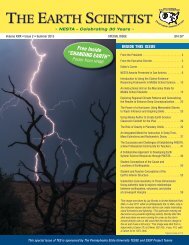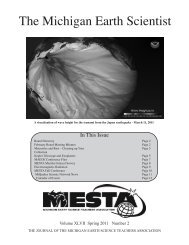The Earth Scientist
Fall 12.pdf - NESTA
Fall 12.pdf - NESTA
- No tags were found...
You also want an ePaper? Increase the reach of your titles
YUMPU automatically turns print PDFs into web optimized ePapers that Google loves.
Page 30<br />
<strong>The</strong> <strong>Earth</strong> <strong>Scientist</strong><br />
Lesson Plans and Classroom<br />
Activities from the Climate Literacy<br />
Ambassadors Community<br />
Margaret E. Mooney, Steve Ackerman, Galen A. McKinley,<br />
Tom Whittaker and Tommy Jasmin<br />
Background<br />
In 2007, the Intergovernmental Panel on Climate Change (IPCC) published its fourth assessment of<br />
<strong>Earth</strong>’s Climate. Stating clearly that “warming is unequivocal” and documenting observed warming,<br />
the IPCC laid the foundation for actions to address the impacts of climate change but left a chasm<br />
between evidence presented in the report and the public’s ability to make meaningful responses or<br />
even comprehend climate mechanisms. To bridge this gap, educators at the University of Wisconsin-<br />
Madison (UW) developed an on-line resource for educators clarifying graphs and tables presented<br />
in the IPCC Summary for Policy Makers. <strong>The</strong> Global and Regional Climate Change course debuted in<br />
2008 (http://cimss.ssec.wisc.edu/climatechange/). Teachers from Wisconsin and California worked<br />
through the content and provided feedback via embedded questionnaires and telephone interviews.<br />
Revisions followed and in 2010, with support from NASA award number NNX10AB52A, the UW<br />
began offering Global and Regional Climate Change as a professional development opportunity for<br />
middle and high school science teachers as part of a Climate Literacy Ambassadors project, the idea<br />
being that teachers would take the course and then promote climate awareness in their schools and<br />
communities. Since then, dozens of teachers have designed and submitted grade-specific lesson<br />
plans that support teaching and learning around climate change. This article highlights a few of the<br />
more robust lesson plans available for download, including a district-wide community action plan<br />
and numerous shorter activities suitable for classroom instruction.<br />
<strong>The</strong> UW Global and Regional Climate Change course and<br />
activities for the classroom<br />
<strong>The</strong>re are 16 lessons grouped into five units in the UW Global and Regional Climate Change course.<br />
<strong>The</strong> content in each of the 16 lessons is freely available on-line, and each lesson includes several<br />
learning activities that reinforce the main concepts presented. Most of these activities are perfect for<br />
classroom instruction. While there is the option to take the entire course and print out a certificate<br />
of completion, users are free to skip the log-in option and go directly to course content. To get to<br />
your favorite activity or lesson plan, simply use the navigation bar along the top of the home page.<br />
A list of 48 activities can be found under the “Resources” tab. While several of the activities are from<br />
NASA or NOAA, most, such as the Carbon Projections Applet to explore future carbon emission<br />
scenarios and the Milankovitch Cycles Applet to explore past climates, were developed at the UW.<br />
© 2012 National <strong>Earth</strong> Science Teachers Association. All Rights Reserved.






